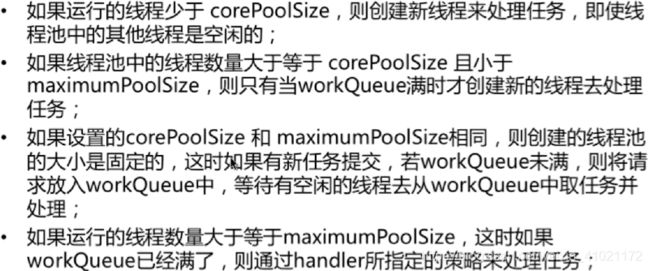线程池与阻塞队列详解
线程池
线程池介绍
一种线程使用模式。线程过多会带来调度开销,进而影响缓存局部性和整体性能。而线程池维护着多个线程,等待着监督管理者分配可并发执行的任务。这避免了在处理短时间任务时创建与销毁线程的代价。线程池不仅能够保证内核的充分利用,还能防止过分调度。
可以通俗理解为,在一个容器中存储了一些已经存在的线程,再有请求进来的时候可以直接调用,而不用创建新的先城市里,同时可以管理线程任务的调度和流程。
线程池的最上层接口是Executor,这个接口定义了一个核心方法execute(Runnabel command),这个方法最后被ThreadPoolExecutor类实现,这个方法是用来传入任务的。而且ThreadPoolExecutor是线程池的核心类,此类的构造方法如下:
public ThreadPoolExecutor(int corePoolSize,int maximumPoolSize,long keepAliveTime,TimeUnit unit,
BlockingQueue<Runnable> workQueue);
public ThreadPoolExecutor(int corePoolSize,int maximumPoolSize,long keepAliveTime,TimeUnit unit,
BlockingQueue<Runnable> workQueue,ThreadFactory threadFactory);
public ThreadPoolExecutor(int corePoolSize,int maximumPoolSize,long keepAliveTime,TimeUnit unit,
BlockingQueue<Runnable> workQueue,RejectedExecutionHandler handler);
public ThreadPoolExecutor(int corePoolSize,int maximumPoolSize,long keepAliveTime,TimeUnit unit,
BlockingQueue<Runnable> workQueue,ThreadFactory threadFactory,RejectedExecutionHandler handler);
构造函数参数:
- corePoolSize:核心线程数量
- maximumPoolSize:线程不够用时能够创建的最大线程数
- workQueue:任务等待队列,使用BlockingQueue阻塞队列
- keepAliveTime:当线程池中的线程数量大于
corePoolSize的时候,如果这时没有新的任务提交,核心线程外的线程不会立即销毁,而是会等待,直到等待的时间超过了keepAliveTime才会被回收销毁。- unit :keepAliveTime 参数的时间单位。
- threadFactory:创建新线程,Executors.defaultThreadFactory()
- 通过复写其newThread方法,实现创建线程。
- handler:线程池饱和策略
- AbortPolicy:直接抛出异常,默认策略
- CallerRunsPolicy:调用执行自己的线程运行任务。您不会任务请求。但是这种策略会降低对于新任务提交速度,影响程序的整体性能。另外,这个策略喜欢增加队列容量。如果您的应用程序可以承受此延迟并且你不能任务丢弃任何一个任务请求的话,你可以选择这个策略。
- DiscardPolicy :不处理新任务,直接丢弃掉。
- DiscardOldestPolicy:此策略将丢弃最早的未处理的任务请求。
- 实现RejectedExecutionHandler接口自定义handler
线程池的运行流程:
线程池的状态
- RUNNING:能接受新提交的任务,并且也能处理阻塞队列中的任务,
- SHUTDOWN:不再接受新提交的任务,但可以处理存量任务
- STOP:不再接受新提交的任务,也不处理存量任务
- TIDYING:所有任务都已终止
- TERMINATED:terminated方法执行完后进入该状态
线程池的大小如何选定
- CPU密集型:线程数=按照核数或者核数+1设定
- I/O密集型:线程数=CPU核数*(1+平均等待时间/平均工作时间)
java类中现有的线程池
我们也可以使用Executor的静态方法,创建java中已有的线程池。

public static ExecutorService newFixedThreadPool(int nThreads) {
return new ThreadPoolExecutor(nThreads, nThreads,
0L, TimeUnit.MILLISECONDS,
new LinkedBlockingQueue<Runnable>());
}
public static ExecutorService newSingleThreadExecutor() {
return new FinalizableDelegatedExecutorService
(new ThreadPoolExecutor(1, 1,
0L, TimeUnit.MILLISECONDS,
new LinkedBlockingQueue<Runnable>()));
}
public static ExecutorService newCachedThreadPool() {
return new ThreadPoolExecutor(0, Integer.MAX_VALUE,
60L, TimeUnit.SECONDS,
new SynchronousQueue<Runnable>());
}
在《阿里巴巴 Java 开发手册》“并发处理”这一章节,明确指出线程资源必须通过线程池提供,不允许在应用中自行显示创建线程。
为什么呢?
使用线程池的好处是减少在创建和销毁线程上所消耗的时间以及系统资源开销,解决资源不足的问题。如果不使用线程池,有可能会造成系统创建大量同类线程而导致消耗完内存或者“过度切换”的问题。
另外《阿里巴巴 Java 开发手册》中强制线程池不允许使用 Executors 去创建,而是通过 ThreadPoolExecutor 构造函数的方式,这样的处理方式让写的同学更加明确线程池的运行规则,规避资源耗尽的风险
Executors 返回线程池对象的弊端如下:
- FixedThreadPool 和 SingleThreadExecutor : 允许请求的队列长度为Integer.MAX_VALUE,可能堆积大量的请求,从而导致 OOM。
- CachedThreadPool 和ScheduledThreadPool : 允许创建的线程数量为 Integer.MAX_VALUE ,可能会创建大量线程,从而导致OOM。
阻塞队列
BlockingQueue:提供可阻塞的入队和出队操作
下面主要介绍一下:ArrayBlockingQueue、LinkedBlockingQueue、PriorityBlockingQueue,这三个 BlockingQueue 的实现类。
ArrayBlockingQueue
ArrayBlockingQueue 是 BlockingQueue 接口的有界队列实现类,底层采用数组来实现。ArrayBlockingQueue 一旦创建,容量不能改变。其并发控制采用可重入锁来控制,不管是插入操作还是读取操作,都需要获取到锁才能进行操作。当队列容量满时,尝试将元素放入队列将导致操作阻塞;尝试从一个空队列中取一个元素也会同样阻塞。
ArrayBlockingQueue 默认情况下不能保证线程访问队列的公平性,所谓公平性是指严格按照线程等待的绝对时间顺序,即最先等待的线程能够最先访问到 ArrayBlockingQueue。而非公平性则是指访问 ArrayBlockingQueue 的顺序不是遵守严格的时间顺序,有可能存在,当 ArrayBlockingQueue 可以被访问时,长时间阻塞的线程依然无法访问到 ArrayBlockingQueue。如果保证公平性,通常会降低吞吐量。如果需要获得公平性的 ArrayBlockingQueue,可采用如下代码:
private static ArrayBlockingQueue<Integer> blockingQueue = new ArrayBlockingQueue<Integer>(10,true);
LinkedBlockingQueue
LinkedBlockingQueue 底层基于单向链表实现的阻塞队列,可以当做无界队列也可以当做有界队列来使用,同样满足 FIFO 的特性,与 ArrayBlockingQueue 相比起来具有更高的吞吐量,为了防止 LinkedBlockingQueue 容量迅速增,损耗大量内存。通常在创建 LinkedBlockingQueue 对象时,会指定其大小,如果未指定,容量等于 Integer.MAX_VALUE。
相关构造方法:
/**
*某种意义上的无界队列
* Creates a {@code LinkedBlockingQueue} with a capacity of
* {@link Integer#MAX_VALUE}.
*/
public LinkedBlockingQueue() {
this(Integer.MAX_VALUE);
}
/**
*有界队列
* Creates a {@code LinkedBlockingQueue} with the given (fixed) capacity.
*
* @param capacity the capacity of this queue
* @throws IllegalArgumentException if {@code capacity} is not greater
* than zero
*/
public LinkedBlockingQueue(int capacity) {
if (capacity <= 0) throw new IllegalArgumentException();
this.capacity = capacity;
last = head = new Node<E>(null);
}
PriorityBlockingQueue
PriorityBlockingQueue 是一个支持优先级的无界阻塞队列。默认情况下元素采用自然顺序进行排序,也可以通过自定义类实现 compareTo() 方法来指定元素排序规则,或者初始化时通过构造器参数 Comparator 来指定排序规则。
PriorityBlockingQueue 并发控制采用的是 ReentrantLock,队列为无界队列(ArrayBlockingQueue 是有界队列LinkedBlockingQueue 也可以通过在构造函数中传入 capacity 指定队列最大的容量,但是 PriorityBlockingQueue 只能指定初始的队列大小,后面插入元素的时候,如果空间不够的话会自动扩容)。
简单地说,它就是 PriorityQueue 的线程安全版本。不可以插入 null 值,同时,插入队列的对象必须是可比较大小的(comparable),否则报 ClassCastException 异常。它的插入操作 put 方法不会 block,因为它是无界队列(take 方法在队列为空的时候会阻塞)。
阻塞队列详解转自javaGuide
线程池部分转自


